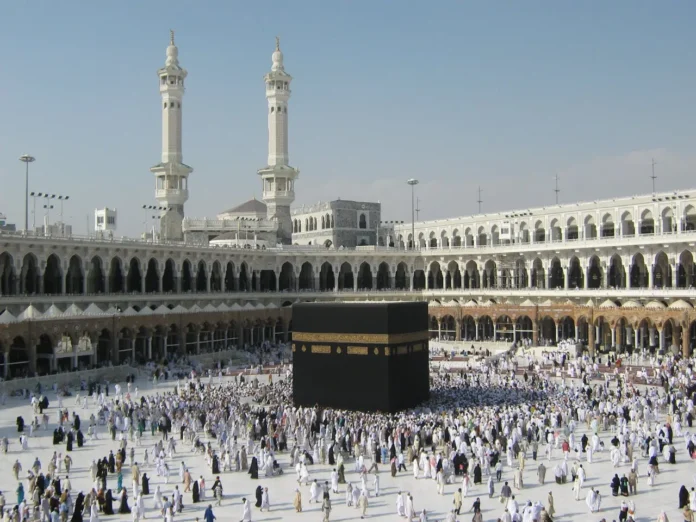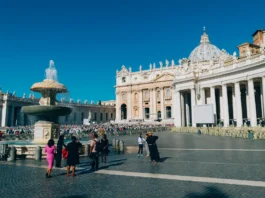“A cube of stone, infinite in meaning — where millions bow, walk, and weep in unity before the Divine.”
In the sacred city of Mecca, amidst the arid hills of western Saudi Arabia, stands the Kaaba — a simple, cubical structure draped in black cloth, yet revered as the most sacred site in Islam. It is the spiritual center not only of a mosque but of the Muslim world itself, drawing millions each year in one of the most powerful displays of collective devotion: the Hajj pilgrimage.
A Sacred Symbol Older Than Time
According to Islamic tradition, the Kaaba was originally built by the Prophet Ibrahim (Abraham) and his son Ismail (Ishmael) as a house of monotheistic worship. Long before Islam’s emergence in the 7th century CE, it stood as a revered shrine, though surrounded at the time by pagan idols.
In 630 CE, Prophet Muhammad (peace be upon him) reclaimed the Kaaba, purifying it of its idols and rededicating it solely to the worship of Allah. From that moment onward, the Kaaba became the qibla — the direction toward which over two billion Muslims around the world turn when they pray, five times a day.
The House of Allah: Simplicity Meets Eternity
The Kaaba’s physical form is striking in its simplicity — a cube approximately 13 meters high, constructed of granite and covered in a black silk cloth called the Kiswah, embroidered in gold with Quranic verses. It is not its architecture, but its spiritual weight that gives it power.
Embedded in its eastern corner is the Black Stone (al-Hajar al-Aswad), believed to have come from paradise. Pilgrims strive to touch or kiss it during the Tawaf — the ritual of circling the Kaaba seven times — though even pointing toward it with reverence is considered enough when the crowds are too dense.
Masjid al-Haram: The Sacred Mosque that Holds the Heart
The Kaaba sits at the center of Masjid al-Haram, the largest mosque in the world. Constantly expanding to accommodate the growing number of pilgrims, it now covers an area of over 400,000 square meters, with capacity for over two million worshippers during peak Hajj seasons.
The mosque is not only the site of the Hajj (one of the Five Pillars of Islam) but also the destination for the Umrah, the lesser pilgrimage that can be performed at any time of the year. Pilgrims walk between the hills of Safa and Marwah, pray behind Maqam Ibrahim, and drink from the sacred Zamzam Well, all within the bounds of the Grand Mosque.
A Tapestry of Faith and Unity
What makes the Kaaba so profoundly moving is not only its religious significance, but what it represents: unity. People of every nationality, language, race, and background come dressed in the same simple white garments, performing the same rituals, declaring the same words:
“Labbayka Allahumma Labbayk”
(“Here I am, O Allah, here I am”).
In a world often divided, the Kaaba stands as a symbol of spiritual oneness. For Muslims, being near it is a moment of overwhelming humility, gratitude, and submission. The experience often brings tears — not of sadness, but of closeness to something eternal.
Preservation, Expansion, and Reverence
Over the centuries, the Kaaba has undergone several renovations — due to floods, fires, and structural damage — yet always with utmost care and reverence. The current Kiswah is replaced annually during the Hajj, in a symbolic gesture of renewal and purity.
Meanwhile, Masjid al-Haram continues to evolve. Modern expansions include towering minarets, underground passages, and high-tech crowd control systems to ensure safety for the millions who visit. Yet despite the scale of modernity, the spiritual essence remains untouched.
Beyond the Stone — A Spiritual Compass
To the believer, the Kaaba is not worshipped — it is a direction, a focus, a symbol of the oneness of God and the unity of the Muslim Ummah. It reminds the faithful of submission, humility, and the eternal bond between Creator and creation.
Even for those who have not yet made the pilgrimage, the image of the Kaaba — silent and still, yet constantly encircled by worshippers — serves as a living reminder of their faith. It represents the center of a spiritual world, an anchor for the heart.




